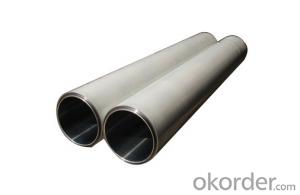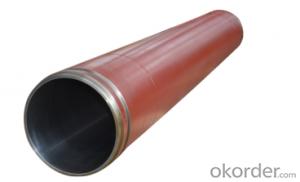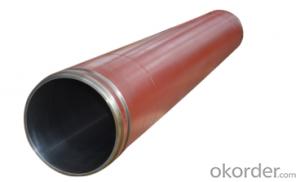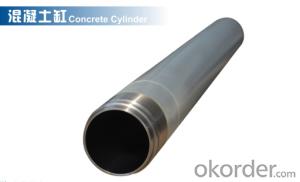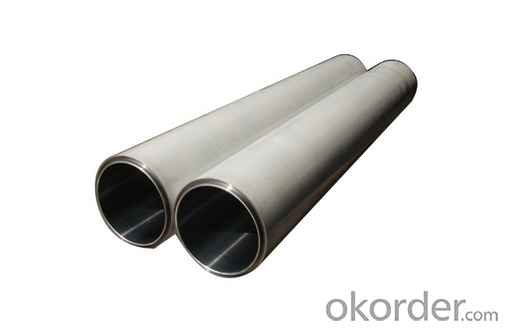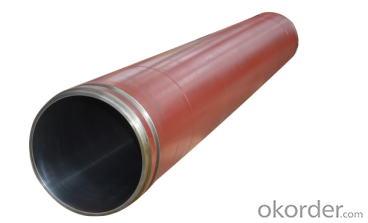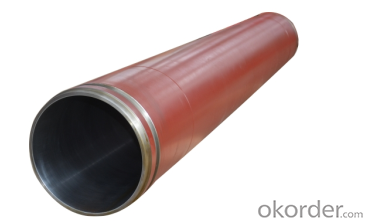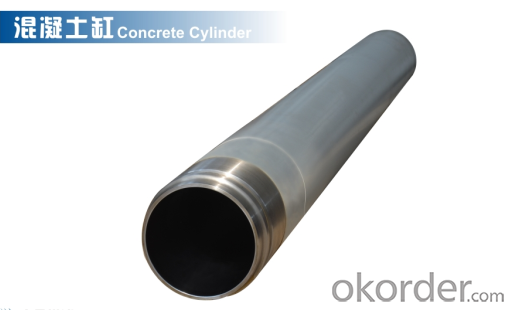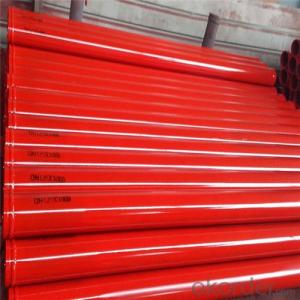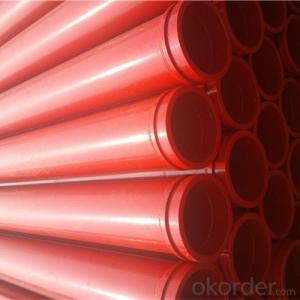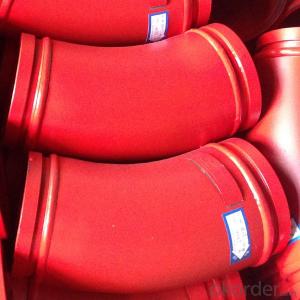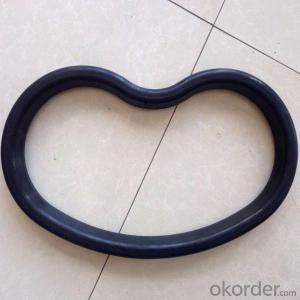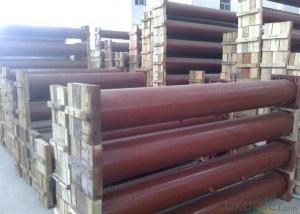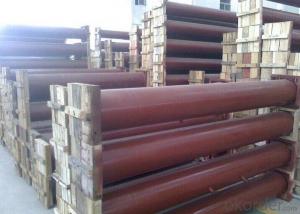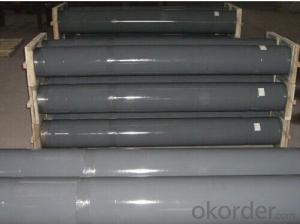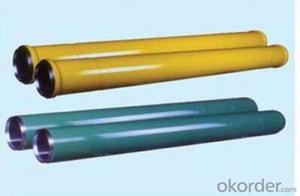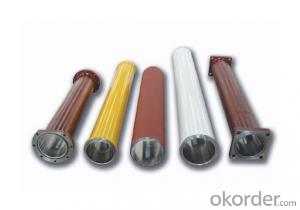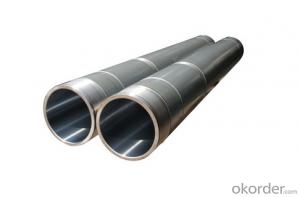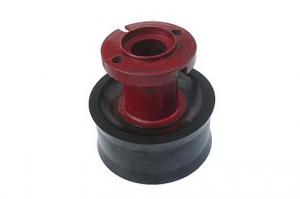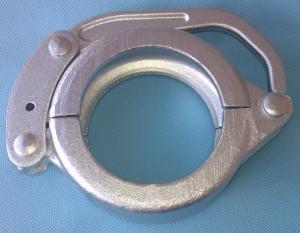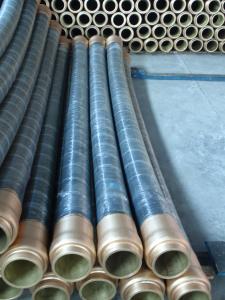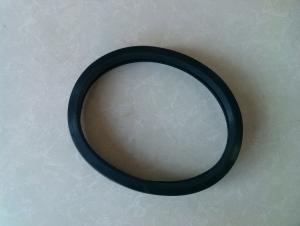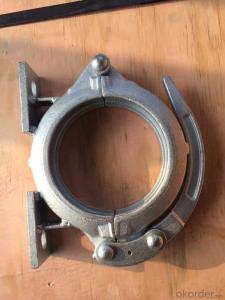PUMPING CYLINDER(PM) I.D.:DN180 CR. THICKNESS :0.25MM-0.3MM LENGTH:2000MM
- Loading Port:
- Shanghai
- Payment Terms:
- TT OR LC
- Min Order Qty:
- 2 pc
- Supply Capability:
- 1000 pc/month
OKorder Service Pledge
OKorder Financial Service
You Might Also Like
Product Description:
The Concrete Pump Delivery Cylinder DN180*2000 normally made by steel material No. C45. according to customer’s requests, and also package in bundles or nude packing directly put into container.
Scope of Application of the Cylinders
The Pump Delivery Cylinder DN180*2000 is a Cylinder pumping for combined use with other concrete pumps parts in concrete pumping operations. It can be widely used in the construction of various types of concrete structures like industrial and civil buildings, bridges, roads, and other types of infrastructure.
This Cylinder Cylinder DN180*2000 can only be used in concrete pump construction operations, but not in any other operations, like dragging, moving, or hoisting heavy articles or personnel. The pipe is also not allowed to be used in any location where any combustible or explosive material exists or a cave-in may occur.
Specifications:
Concrete Pump Delivery Cylinder DN180*2000
1. Capacity: 60,000~80,000cbm
2. Size: DN180, DN200, DN230.DN250
3. Material: C45
4. quenching and tempering to improve the hardness to HB241-280
5. inner wall chrome thickness is 0.25-0.30mm, hardness HV820-900.
6. Brand: SCHWING, PM, SANY, KYOKUTO, CIFA
7. Capacity: 60,000~80,000cbm
Product Advantages:
OKorder's Cylinders DN180*2000 Channels are durable, strong, and safety.
Main Product Features:
· Premium quality
· Prompt delivery & seaworthy packing (10-20 days)
Reliable performance
Easy to weld
High safety.
· Professional Service
· Competitive pricing
Measuring of wall thickness from the outside
Low purchase cost
FAQ:
Q1: How long about delivery time about DN180*2000 ?
A1: Normally we keep the raw materials for old customers and sometime we also keep stock products to make sure delivery time in any emergency cases.
Q2: How do we guarantee the quality of our Cylinders DN180*2000?
A2: We have established an advanced quality management system which conducts strict quality tests at every step, from raw materials to the final product. At the same time, we provide extensive follow-up service assurances as required.
Q3: How soon can we receive the product after purchase?
A3: Within three days of placing an order, we will book the vessel for goods. The specific shipping date is dependent upon international and government factors, but is typically10 to 30 workdays.
Q4: If we can produce some Cylinders DN180*2000 according to customers request?
A4: Yes, we can produce Cylinders DN180*2000 according to the difference country situations to make it suitable to the market and customers. We have very professional technical team to make the design.
Q5: How to make a quick resolution for after service?
A5: OKorder and our manufacture both have overseas branches all-around of world.
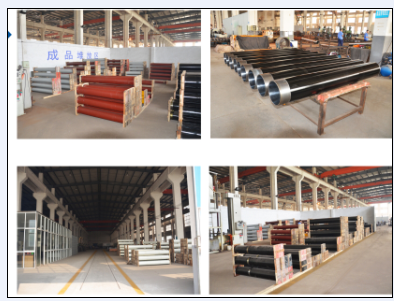
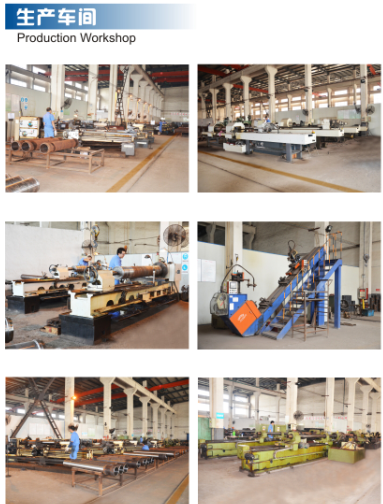

- Q: How do I determine the correct temperature ratings for concrete pump spare parts?
- Determining the appropriate temperature ratings for spare parts of your concrete pump requires careful consideration of the specific requirements and specifications of your pump system. To assist you in this process, the following steps can be taken: 1. Review the manufacturer's documentation: Begin by examining the technical specifications provided by the manufacturer of your concrete pump system. The manufacturer should furnish temperature ratings for various components and spare parts. Look for information regarding temperature limits, recommended operating temperature ranges, as well as any specific guidelines or restrictions pertaining to temperature. 2. Identify crucial components: Identify the key components of your concrete pump system that may be impacted by temperature, such as hoses, seals, gaskets, valves, and electrical components. These components may possess different temperature ratings based on the materials used and their specific design. 3. Evaluate application conditions: Assess the operating conditions of your concrete pump system to determine the potential temperature extremes it may encounter. Factors such as ambient temperature, concrete mix temperature, and the presence of external heat sources (e.g., hot weather or neighboring equipment) can influence the temperature of the system and its spare parts. 4. Verify compatibility: Ensure that the spare parts you are considering are compatible with the specific temperature range of your concrete pump system. Some components may possess different ratings based on factors like chemical compatibility, thermal expansion, and resistance to heat transfer. 5. Seek professional advice: If you are uncertain about the temperature ratings or require further clarification, it is advisable to consult professionals or experts in the field of concrete pump systems. They can offer specific recommendations based on their knowledge and experience. By following these steps and considering the manufacturer's guidelines and expert advice, you can determine the appropriate temperature ratings for spare parts of your concrete pump, thus guaranteeing the safe and efficient operation of your system.
- Q: How often should a concrete pump cleaning ball be used?
- A concrete pump cleaning ball should be used after every pumping job or at least once a day to ensure the cleanliness and proper functioning of the pump. The cleaning ball helps remove any build-up or debris that may have accumulated inside the pump and its pipes during the pumping process. Regular use of a cleaning ball helps prevent clogs and blockages, ensuring a smooth and efficient pumping operation.
- Q: How do I identify the right spare part for my concrete pump model?
- To identify the right spare part for your concrete pump model, you should start by referring to the user manual or documentation provided by the manufacturer. This will usually include a detailed parts list and diagrams specific to your model. If you don't have access to the manual, you can contact the manufacturer or a reputable supplier for assistance. They will require information such as the pump model number, serial number, and specific details about the part you need. It's important to provide as much accurate information as possible to ensure you get the correct spare part for your concrete pump.
- Q: How often should concrete pump pistons be replaced?
- The frequency of replacing concrete pump pistons can vary depending on several factors such as the type of pump, the quality of the pistons, and the intensity of usage. However, as a general guideline, concrete pump pistons should be inspected regularly and replaced whenever signs of excessive wear or damage are observed. Timely replacement is crucial to ensure optimal pumping performance and prevent potential breakdowns.
- Q: What is the function of a concrete pump control lever?
- The function of a concrete pump control lever is to regulate the flow and direction of concrete being pumped, allowing the operator to precisely control the placement and distribution of concrete during construction projects.
- Q: What are the fittings of concrete pump?
- Hydraulic oil, eye plates, cutting rings (when the equipment reaches 5000 or more sides can be prepared) and so on
- Q: How often should concrete pump control levers be inspected and replaced?
- Concrete pump control levers should be inspected regularly, ideally on a monthly basis, to ensure they are in proper working condition. However, the need for replacement would depend on various factors such as the quality of the lever, frequency of use, and any signs of wear or damage. If any issues or concerns arise during inspection, prompt replacement should be considered to maintain safe and efficient operation of the concrete pump.
- Q: Are there any specific safety precautions for handling concrete pump spare parts?
- Concrete pump spare parts require specific safety precautions to be followed. It is essential to wear the appropriate personal protective equipment (PPE) like gloves, safety goggles, and a dust mask. This ensures protection against potential hazards, as concrete dust can harm the skin and cause respiratory issues if inhaled. Proper lifting techniques are crucial when handling these spare parts to prevent strains or injuries. Heavy parts should be lifted using lifting equipment or with the assistance of others to minimize accidents. Moreover, it is vital to handle the spare parts with care and avoid rough handling or dropping to prevent damage or breakage. Damaged spare parts can negatively impact the concrete pump's performance and safety. Storing the spare parts in a clean, dry area away from moisture or chemicals is also important. This prevents potential damage that may compromise the quality and integrity of the spare parts. Lastly, it is advisable to always follow the manufacturer's instructions and guidelines for handling concrete pump spare parts. They provide specific safety precautions and recommendations, ensuring the parts are handled and used safely. By adhering to these safety precautions, the risk of accidents, injuries, and damage to the concrete pump spare parts can be minimized, creating a safe working environment.
- Q: What is the importance of a concrete pump control valve?
- A concrete pump control valve is important because it allows for precise control and regulation of the flow rate and pressure of concrete being pumped. This ensures that the concrete is delivered accurately and efficiently to the desired location, preventing wastage and improving overall productivity of the construction process. Additionally, the control valve prevents blockages and potential damage to the pump by allowing operators to adjust the flow as needed, maintaining a smooth and continuous operation.
- Q: What are the common causes of overheating in concrete pump spare parts?
- There are several common causes of overheating in concrete pump spare parts. One of the main reasons is improper lubrication. If the moving parts of the pump, such as bearings and pistons, are not properly lubricated, there is increased friction which leads to overheating. It is important to regularly check and maintain the lubrication system to ensure smooth operation and prevent overheating. Another common cause is excessive use or continuous operation without breaks. Concrete pumps are designed to handle a certain workload, and if they are used beyond their capacity or without proper rest periods, the components can overheat. It is crucial to follow the recommended operating guidelines and allow the pump to cool down periodically to prevent overheating. Furthermore, clogged or blocked cooling systems can also contribute to overheating. The cooling system in a concrete pump helps regulate the temperature by circulating coolant around the engine and other important parts. If the cooling system becomes clogged with debris or the coolant level is low, the pump may overheat. Regularly inspecting and cleaning the cooling system, as well as maintaining the appropriate coolant levels, can prevent overheating. Inadequate ventilation is another common cause of overheating. Concrete pumps generate a significant amount of heat during operation, and if the surrounding environment does not allow for proper airflow, the heat cannot dissipate effectively. This can lead to overheating of the spare parts. Ensuring that the pump is operated in well-ventilated areas or using additional cooling measures, such as fans or air conditioning, can help prevent overheating. Lastly, a malfunctioning or damaged pump component can also cause overheating. If a part of the pump, such as the motor or the hydraulic system, is not functioning correctly, it can put additional strain on other components, leading to overheating. Regular maintenance and inspection of the pump's components can help identify and address any potential issues before they cause overheating. Overall, proper lubrication, following operating guidelines, maintaining cooling systems, ensuring adequate ventilation, and regular maintenance are crucial in preventing overheating in concrete pump spare parts.
Send your message to us
PUMPING CYLINDER(PM) I.D.:DN180 CR. THICKNESS :0.25MM-0.3MM LENGTH:2000MM
- Loading Port:
- Shanghai
- Payment Terms:
- TT OR LC
- Min Order Qty:
- 2 pc
- Supply Capability:
- 1000 pc/month
OKorder Service Pledge
OKorder Financial Service
Similar products
Hot products
Hot Searches
Related keywords
